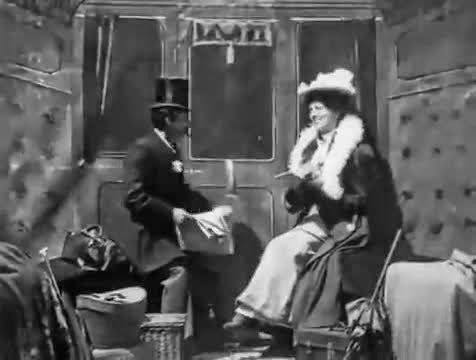Nationality British Siblings Eva Bayley | Occupation Actor, filmmaker | |
 | ||
Born 1864 ( 1864 ) Spouse George Albert Smith (m. 1888) Other names Laura Eugenia Smith, Mrs. George Albert Smith Movies The Kiss in the Tunnel, Mary Jane's Mishap, The X‑Rays, The Death of Poor Joe, Let Me Dream Again | ||
Laura Eugenia Bayley (1864 – 1938) was a British actor and filmmaker, active in the Brighton School of early cinema pioneers. Born in Ramsgate, Bayley performed onstage in Victorian burlesques, revues, and pantomimes, often with her three sisters. After marrying the showman George Albert Smith, she entered the world of early experiments with motion picture film; she played main roles in many of the most important films Smith made between 1897 and 1903, including The Kiss in the Tunnel (1899) and Mary Jane's Mishap (1903).
Contents
Behind the camera, Bayley likely played a significant hand in the creative development of Smith's fiction films, and may have directed some of those currently credited to him. She also directed and supervised numerous other films on her own, including a series for an early show-at-home projector design. Film historians have highlighted her prolific career as a film performer as well as the creative talent she brought to filmmaking.
Early life and stage career
Bayley was born in 1864 in the English seaside town of Ramsgate. She and her sisters Blanche, Florence, and Eva worked together as performers for J. D. Hunter's Theatre Company, which produced a "burlesque" extravaganza every year at the Brighton Aquarium. The Brighton Society, in 1887, praised "the Misses Bayley … who, by their charming vocal selections added so considerably to the success of the burlesque Brown and the Brahmins".
Bayley's three sisters also performed without her for some Aquarium productions, such as in Cinderella and Dick Whittington in August 1890 and again in the latter in 1892, but the four sisters were reunited at the Aquarium for Babes in the Wood in 1894, about which the Brighton Herald commented that "The Robin Hood of Miss Laura Bayley is a distinctly comely and cheery Robin Hood".
In 1888, when Bayley was twenty-four, she married George Albert Smith in Ramsgate. Smith was a young stage entertainer, performing hypnosis acts and second sight routines in local venues, including the Brighton Aquarium. The couple had two children, Harold Norman and Dorothy Eugenie, in 1889 and 1890, respectively. In 1892, Smith acquired a lease on St. Ann's Well and Wild Garden, a pleasure garden in Brighton; it reopened under his management the following spring. Together, Bayley and Smith mounted summer fancy dress parties, attended by as many as 2,000 costumed patrons, at the garden. Smith also gave magic lantern performances and dioramic lectures, and exhibited the newly invented Edison phonograph, as part of the garden's entertainments.
Film career
Smith's interest in novel forms of entertainment led him toward early experiments with motion picture film, and in 1897 he began making short films on the St. Ann's Well grounds. By the time of Smith's foray into filmmaking, Bayley had had wide experience in comic acting for pantomime and revues, and Smith drew extensively on her knowledge of visual humor and audience tastes. She played lead roles in many of his most significant films, including Hanging out the Clothes (1897), Santa Claus (1898), Cinderella (1898), The Kiss in the Tunnel (1899), As Seen Through the Telescope (1900), Let Me Dream Again (1900), Dorothy's Dream (1900), and Mary Jane's Mishap (1903). Bayley also appeared in some of Smith's 1906 and 1908 tests of the color-film process Kinemacolor.
Other members of Bayley's family also became involved in Smith's filmmaking; all three of her sisters probably appeared in his films, as did her two children; notably, the film historian Frank Grey suggested that Harold and Dorothy Smith probably both appear in Santa Claus and The House that Jack Built, and that Harold also plays the grandson in Grandma's Reading Glass.
During her acting career, Bayley also worked on her own as a filmmaker, making numerous short films that were designed and marketed for a home projector, the Biokam. Smith and Bayley probably worked in creative collaboration to devise the fiction films Smith directed; Bayley may also have directed some of the films currently credited to Smith, as his records indicate that she supervised the "facials" (comic short films emphasizing facial expression). Bayley also participated in the process of making cameras.
Legacy
The British Film Institute's Screenonline database ranks Bayley as "the most prolific British actress" in turn-of-the-century cinema. In program notes for the Pordenone Silent Film Festival, where three Bayley films were shown in 2002, the film historian David Robinson cited Bayley and her sisters as the first known comediennes in British film.
In a discussion of Bayley's collaboration with Smith, the film historian Frank Gray wrote: "Laura Bayley brought to this creative work a keen understanding of popular texts, an unself-conscious and dynamic style of acting and a rich sense of humour. Audiences which still laugh at her winking at the camera when watching Mary Jane's Mishap are acknowledging her considerable achievement."
